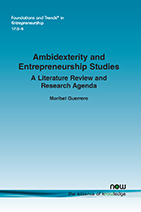Ambidexterity and Entrepreneurship Studies: A Literature Review and Research Agenda
By Maribel Guerrero, Business and Economics Faculty, Universidad del Desarrollo, Chile and Northumbria Centre for Innovation, Regional Transformation, and Entrepreneurship (iNCITE), Newcastle Business School, Northumbria University, United Kingdom, maribel.guerrero@northumbria.ac.uk
Abstract
Originated by an individual capacity, organizational ambidexterity represents how organizations do two different things equally well (i.e., efficiency and flexibility, adaptability and alignment, integration and responsiveness, or exploration and exploitation). The versatility of the ambidexterity concept allows using it to test multiple research questions from various perspectives. It explains that in the last decades, the research in organizational ambidexterity has been exponentially rising. The authors argued that the proliferation of papers represents a consolidation stage of any phenomenon. Therefore, in this development cycle, the two possibilities maybe its decline or re-focus along new lines.
Although the publication pattern focused on strategic management journals, it does not mean that organizational ambidexterity is only observed in established and mature organizations’ strategies. Several entrepreneurial organizations have been born (e.g., new ventures) or have rejuvenated (i.e., established ventures with an entrepreneurial orientation) by implementing and developing an organizational ambidexterity capacity. This study is motivated by the apparent unrepresentativeness of organizational ambidexterity in entrepreneurship studies. Therefore,
- (a) we look back to the past 15 years of published research by focusing on the contribution of organizational ambidexterity to the fields of management studies and entrepreneurship studies; and
- (b) we look forward to the research in organizational ambidexterity by inspiring the analysis of ambidexterity’s role in the current scenarios (social, economic, technological, environmental) in management and entrepreneurship studies.
Based on this review and analysis, we show the underrepresentation of entrepreneurship in the published ambidexterity literature until the last decade (the 2010s). Motivated by this insight, we provoke the discussion about how the concept of ambidexterity, characterized by managing a double tension simultaneously, is a potential ingredient in the entrepreneurial decision-making process of individuals, teams, organizations, and eco-systems agents. We encourage new research lines that help refresh the analysis of ambidexterity in the entrepreneurship field and re-thinking its contribution to the reconciliation process between management, innovation, and entrepreneurship fields. Furthermore, several implications to managers, entrepreneurial organizations, and entrepreneurs emerge from this study. Concretely, we encourage them to consider this approach as a way of thinking to face the current social, economic, and health problems that we are living in due to the COVID-19 pandemic effects.
Ambidexterity and Entrepreneurship Studies: A Literature Review and Research Agenda
Organizational ambidexterity represents how organizations do two different things equally well, such as efficiency and flexibility, adaptability and alignment, integration and responsiveness, or exploration and exploitation. Several entrepreneurial organizations have been born or rejuvenated by implementing and developing an organizational ambidexterity capacity. Ambidexterity and Entrepreneurship Studies: A Literature Review and Research Agenda reviews organizational ambidexterity in entrepreneurship studies. The author examines the past 15 years of published research by focusing on the contribution of organizational ambidexterity to the fields of management studies and entrepreneurship studies and provide research directions in organizational ambidexterity. Based on this review and analysis, the author shows the underrepresentation of entrepreneurship in the published ambidexterity literature until the last decade. Motivated by this insight, the discussion examines how the concept of ambidexterity is a potential ingredient in the entrepreneurial decision-making process of individuals, teams, organizations, and eco-systems agents. New research lines are encouraged that refresh the analysis of ambidexterity in the entrepreneurship field and re-think its contribution to the reconciliation process between management, innovation, and entrepreneurship fields. Finally, there are several implications for managers, entrepreneurial organizations, and entrepreneurs that emerge from this study.
